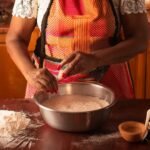In today’s fast-paced world, where convenience often takes precedence over tradition, neighborhood bakeries stand as quaint reminders of a simpler time. These establishments, with their warm aromas and freshly baked goods, hold a special place in the hearts of communities worldwide. Beyond merely satisfying hunger, they serve as focal points for social interaction, cultural exchange, and culinary tradition. This essay delves into the enchantment of neighborhood bakeries, exploring the stories behind favorite breads and the significance of these establishments in contemporary society.
The Role of Neighborhood Bakeries
Neighborhood bakeries are more than just places to purchase bread; they are integral parts of communities, weaving themselves into the fabric of everyday life. Unlike mass-produced bread found in supermarkets, the bread crafted in these establishments often carries with it a sense of artisanal pride and heritage. Each loaf tells a story, not just of ingredients and technique, but of the people and culture behind it.
Social Hubs
One of the most enchanting aspects of neighborhood bakeries is their role as social hubs. People from all walks of life gather here, forming connections over shared love for freshly baked bread. Whether it’s the morning rush for a quick pastry and coffee or the leisurely afternoon chat over a loaf of crusty sourdough, these spaces foster a sense of community that is increasingly rare in today’s society.
According to sociologist Ray Oldenburg, author of “The Great Good Place,” such establishments serve as “third places” outside of home and work where people can relax and engage in meaningful social interaction. Neighborhood bakeries perfectly embody this concept, providing a welcoming environment where customers can linger, converse, and forge bonds with both neighbors and strangers alike.
Cultural Heritage
Furthermore, neighborhood bakeries serve as custodians of cultural heritage, preserving traditional recipes and baking techniques passed down through generations. Each loaf of bread reflects the culinary history of its region, offering a taste of tradition to locals and visitors alike. From the chewy baguettes of France to the hearty rye bread of Scandinavia, these baked goods carry with them the stories and flavors of their respective cultures.
Renowned food writer Michael Pollan once remarked, “If you want to change the culture, you have to change the food.” Neighborhood bakeries play a crucial role in preserving and celebrating culinary traditions, ensuring that cultural heritage remains alive and accessible to future generations.
Stories Behind Favorite Breads
Behind every loaf of bread lies a story—a tale of ingredients, craftsmanship, and cultural significance. Whether it’s the humble bagel or the indulgent brioche, each bread variety has its own unique narrative, shaped by history, geography, and personal anecdotes.
Baguette: A French Icon
The baguette, with its golden crust and airy interior, is perhaps the most iconic of all French breads. Its origins can be traced back to the early 19th century, when advancements in oven technology allowed for the production of longer, thinner loaves. Initially associated with Parisian bakers, the baguette soon became synonymous with French culture, earning a place at dinner tables and sidewalk cafes across the country.
According to food historian Jim Chevallier, author of “August Zang and the French Croissant: How Viennoiserie Came to France,” the baguette’s popularity surged during the Industrial Revolution, as urbanization led to increased demand for portable and affordable bread options. Today, the baguette remains a staple of French cuisine, cherished for its simplicity, versatility, and unmistakable flavor.
Sourdough: A Taste of Tradition
Sourdough bread, characterized by its tangy flavor and chewy texture, has enjoyed a resurgence in popularity in recent years. However, its roots stretch back thousands of years, with evidence of sourdough fermentation dating as far back as ancient Egypt. Unlike commercial yeast, which is added to dough for leavening, sourdough relies on wild yeast and bacteria present in flour and the surrounding environment.
The art of sourdough baking is as much a science as it is a tradition, requiring patience, skill, and a deep understanding of fermentation. Each sourdough starter—a mixture of flour and water left to ferment—carries with it a unique microbial ecosystem, resulting in breads with distinct flavors and textures.
Challah: Symbol of Celebration
Challah, a traditional Jewish bread enriched with eggs and honey, holds a special place in Jewish culture and cuisine. Its braided shape symbolizes unity and continuity, making it a common sight at Sabbath dinners, holidays, and other festive occasions. According to food historian Joan Nathan, author of “Jewish Cooking in America,” the origins of challah can be traced back to ancient Israel, where it was known as “ḥallah” and offered as a portion of dough to priests.
Today, challah remains a beloved staple of Jewish cuisine, cherished for its rich flavor and symbolic significance. Whether served plain, sprinkled with sesame seeds, or stuffed with sweet fillings like raisins or chocolate chips, challah continues to evoke memories of shared meals and joyous gatherings.
Exploring the Fascinating World of Challah: Curiosities and Traditions
Challah, a traditional Jewish bread, holds a rich tapestry of history, symbolism, and culinary significance. Beyond its delicious taste and distinctive braided appearance, challah is steeped in tradition and surrounded by intriguing customs. In this article, we’ll delve into the fascinating world of challah, uncovering its curious origins, unique characteristics, and the rituals that accompany its preparation and consumption.
Origins of Challah
The roots of challah can be traced back to ancient Israel, where it was known as “ḥallah” and played a significant role in religious and social life. In biblical times, a portion of dough known as “ḥallah” was set aside and given to priests as an offering. Over time, this practice evolved into the creation of a distinct type of bread, which eventually became known as challah.
Symbolism and Shape
One of the most distinctive features of challah is its braided shape, which symbolizes unity, continuity, and the intertwining of Jewish traditions. The braids also represent the connection between human beings and the divine, as well as the cycle of life and the Sabbath. Traditionally, challah is braided with either three, four, or six strands, each configuration holding its own symbolic significance.
Rituals and Traditions
The preparation and consumption of challah are accompanied by a variety of rituals and traditions that add depth and meaning to the experience. Before baking, it is customary for the baker to recite a blessing known as “hafrashat challah,” in which a small piece of dough is set aside as an offering. This ritual reflects the biblical commandment to separate a portion of dough for the priests.
Varieties and Flavors
While traditional challah is made with simple ingredients such as flour, water, eggs, and yeast, modern variations abound, incorporating additional ingredients and flavors to suit different tastes and occasions. Popular variations include whole wheat challah, honey challah, and even chocolate chip challah, each offering a unique twist on this beloved bread.
Cultural Significance
Challah holds a special place in Jewish culture and cuisine, serving as a symbol of celebration, community, and tradition. It is commonly served at Sabbath dinners, holidays such as Rosh Hashanah and Yom Kippur, and other festive occasions. Sharing challah with family and friends fosters a sense of togetherness and connection, reinforcing bonds that transcend generations.
Global Influence
While challah has its roots in Jewish tradition, its popularity extends far beyond the Jewish community, with people of all backgrounds embracing this delicious bread. In recent years, challah has gained widespread recognition in the culinary world, appearing on restaurant menus, in cookbooks, and even on social media platforms. Its versatility and distinctive flavor make it a favorite among bread enthusiasts worldwide.
Conclusion
Challah is much more than just a bread—it is a symbol of faith, heritage, and community. Its rich history, unique shape, and deep-rooted traditions make it a fascinating subject of study and exploration. Whether enjoyed fresh from the oven or incorporated into culinary creations, challah continues to captivate hearts and minds with its timeless appeal.
Significance in Contemporary Society
In an era dominated by mass production and fast food chains, neighborhood bakeries offer a welcome respite—a reminder of the value of craftsmanship, community, and connection. Their continued presence in contemporary society speaks to a longing for authenticity, tradition, and human connection in an increasingly digitized world.
Counterbalance to Mass Production
In a world where food is often treated as a commodity rather than a craft, neighborhood bakeries provide a counterbalance to mass production and standardization. Each loaf of bread is a testament to the skill and dedication of the baker, reflecting a commitment to quality and flavor over efficiency and uniformity.
According to food economist Caroline Saunders, author of “Local Food: Environments and Economies,” the resurgence of interest in artisanal food production can be attributed to a growing awareness of the environmental and social costs of industrial agriculture. By supporting local bakeries, consumers not only gain access to fresher, more flavorful bread but also contribute to the vitality of their communities and the sustainability of the food system as a whole.
Catalyst for Community Engagement
Moreover, neighborhood bakeries serve as catalysts for community engagement and revitalization, breathing new life into urban and rural neighborhoods alike. In recent years, initiatives such as “Breadshare” and “Community Supported Bakeries” have emerged, connecting local bakers with consumers and fostering relationships built on trust, transparency, and mutual support.
According to urban planner Jane Jacobs, author of “The Death and Life of Great American Cities,” vibrant neighborhoods are characterized by a mix of uses and activities that encourage pedestrian traffic and social interaction. Neighborhood bakeries, with their inviting storefronts and communal seating areas, embody this principle, creating spaces where people can gather, linger, and connect with their surroundings.
Conclusion
In conclusion, neighborhood bakeries occupy a unique and cherished place in contemporary society, offering more than just bread—they provide a sense of belonging, tradition, and connection to the communities they serve. From the bustling streets of Paris to the quiet corners of small-town America, these establishments continue to enchant and inspire, reminding us of the simple joys of good food and good company. As long as there are stories to be shared and bread to be broken, the enchantment of neighborhood bakeries will endure.
Olá, sou Romero Bachman, fundador e autor principal do Curiositando. Minha jornada começou com a ideia de criar um espaço online dedicado a abordar as questões mais curiosas do nosso cotidiano e que podem impactar em nossas vidas.




